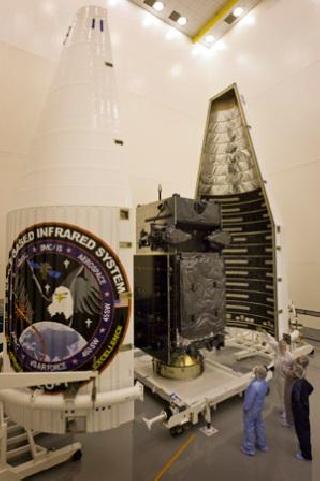
(GEO-1) Space Based Infrared System (SBIRS) missile warning satellite during fairing encapsulation in preparation for an early May launch from Cape Canaveral Air Force Station, Florida. A Lockheed Martin photo
CAPE CANAVERAL (BNS): The Space Based Infrared System (SBIRS) geosynchronous (GEO-1) spacecraft, built by Lockheed Martin, has been encapsulated into its payload fairing in preparation for an early May liftoff aboard an Atlas V rocket.
SBIRS GEO-1 will enhance the nation’s missile warning capabilities and improve other critical mission areas simultaneously including missile defense, technical intelligence and battlespace awareness, Lockheed Martin said in a statement.
The GEO-1 satellite includes highly sophisticated scanning and staring sensors that will deliver enhanced infrared sensitivity and a reduction in area revisit times over the current constellation.
The scanning sensor will provide a wide area surveillance of missile launches and natural phenomena across the earth, while the staring sensor will be used to observe smaller areas of interest with enhanced sensitivity.
When GEO-1 is launched, declared operational and its data is fused into the current constellation, SBIRS will deliver unprecedented, global, persistent, taskable infrared surveillance capabilities to the warfighter, nation and allies for decades to come, it said.
Lockheed Martin is the SBIRS prime contractor, with Northrop Grumman, as the payload integrator. Air Force Space Command operates the SBIRS system.
 Previous Article
Previous Article Next Article
Next Article













The Indian Air Force, in its flight trials evaluation report submitted before the Defence Ministry l..
view articleAn insight into the Medium Multi-Role Combat Aircraft competition...
view articleSky enthusiasts can now spot the International Space Station (ISS) commanded by Indian-American astr..
view article